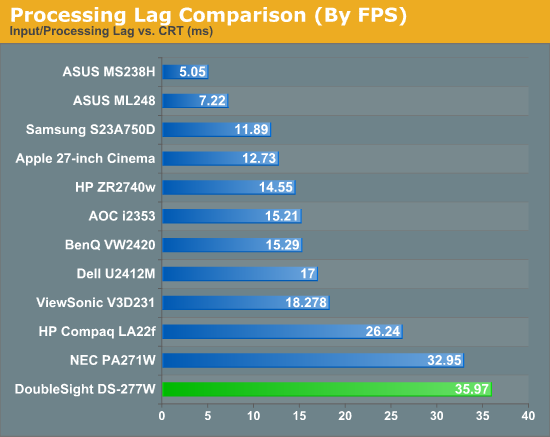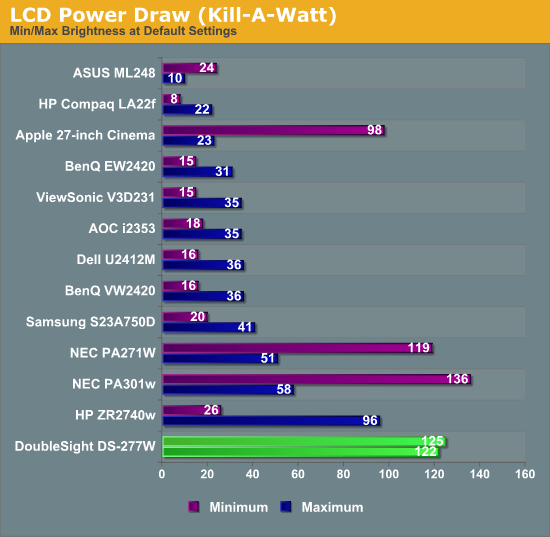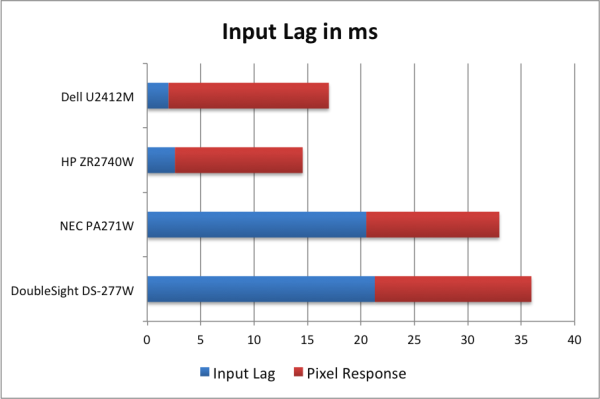DoubleSight DS-277W: Back to the Drawing Board
by Chris Heinonen on June 13, 2012 1:30 AM ESTSince all LCD displays have to be compared to a CRT display to calculate the lag, all of the testing is done at 1920x1080 resolution to keep the aspect ratio constant on the DS-277W. This might introduce a bit of an input delay, but because we use SMTT now to test displays we can separate input lag from pixel response to be more accurate.
Using SMTT, the DS-277W exhibited right around 21.3ms of input lag, and it took a full 29.3ms for a pixel to switch colors and come back, and combined this gives us an average response time of 36ms. This is over two frames of delay, so for many people this will not be an acceptable number for heavy gaming. Since the HP ZR2740w offers far faster pixel response time, and costs less to boot, that would be the 27” display I would still recommend with gaming in mind.

The DS-277W ships with an external power brick, and it seems to draw full current, all the time. At minimum brightness it was using 122 watts and at maximum it was drawing 125. Running at lower brightness to save on your energy bill isn’t a concern here, as the DS-277W is going to use a lot of power no matter how you have it setup.

I also tried to test out the DS-277W as a video display, since it has many inputs to use for this. Using an Oppo BDP-93 Blu-ray player, my first discovery was that in 1:1 mapping mode, it crops pixels from an HDMI signal. Losing 11 pixels on each side and 5 on the top and bottom, this is around 1% of overscan in effect, and there is really no reason for this at all. I did test using a PLUGE pattern from the Blu-ray player and found that the brightness control behaved the same over the HDMI input, controlling the black level as you’d expect on a TV.
Testing component didn’t even get that far. Once again using the Oppo player, which has a near perfect component video output, I couldn’t get an image on the screen at all. Using the Oppo BDP-83SE player instead also resulted in no image, so either the component video on my test LCD didn’t work correctly, or it didn’t like the timing of the Oppo players, or something else is just incorrect with the component video. Needless to say I wasn’t happy with the video testing results.











55 Comments
View All Comments
esSJae - Thursday, June 14, 2012 - link
3 monitors? I use DP for my main monitor on my AMD 6970, DVI for the other 2.6 monitors? Better have DP.
dertechie - Monday, June 18, 2012 - link
Anyone using Eyefinity is using either DP or an expensive DP to X converter. Given what those cost, a lot of us just use DP if we picked up the 3rd monitor in the last 3-4 years.DP has a lot more support than just Apple. It's cheaper on the transmitter side than DVI or HDMI (and probably VGA by now), so such insignificant players as AMD, NVidia and Intel are dropping legacy connectors as quickly as they can get away with it. Much less penetration on the monitor side of things though.
cheinonen - Wednesday, June 13, 2012 - link
Well, the specs said it had DisplayPort, but really we were trying to do a round up of as many 27", 2560x1440 models as possible. There aren't too many of them out there but this was one of them.Mitch89 - Saturday, June 16, 2012 - link
I'm also a little confused about this sentence:"... the DS-277W is to make a monitor that can work with all of your devices, not just your computer. It has multiple AV inputs (HDMI, Component) for your Blu-ray player or video game systems, and there are integrated speakers for audio from these devices as well. "
The Dell U2711 has DisplayPort, 2x DVI, VGA, HDMI, Component and even composite connections, and has been out for quite some time (updating previous 27" Dells that had similar connectivity).
It would seem if multimedia and all-round connectivity is the priority, then the Dell has this thing beat.
That's without considering Dell's excellent exchange warranty.
cheinonen - Saturday, June 16, 2012 - link
In the conclusion I mention the Dell U2711 and that if you need that connectivity, you should buy the Dell instead. I see no reason to pick the DS-277W over the Dell, or really any other 27", and mention that in the conclusion.damianrobertjones - Wednesday, June 13, 2012 - link
All these screens really need to start featuring touchVoo - Saturday, June 16, 2012 - link
Yep stretching your whole body so that you get into touch range of your 30" monitor (you hardly sit 20cm away from one do you?) and then having to deal with all those fingerprints and smears sounds PERFECT! Can't wait for this totally useless feature that will probably double the price of monitors.Jedi2155 - Wednesday, June 13, 2012 - link
I'm not sure if you're familiar with the Yamasaki Catleap, which is a potentially 120 Hz capable 27" IPS display, but I've been really wanting to get one once the people organizing it, can get some more built. I would love an Anandtech review on it as well. I already plan on getting one as soon as they are available, so I don't need you guys to tell me to get one, but it would be good to get more manufacturers on the 120 Hz PC bandwagon that isn't a 3D TN based display....http://120hz.net/content.php
anishannayya - Wednesday, June 13, 2012 - link
Correct me if I'm wrong here, but don't you really need to push 120+ FPS to discern the benefits of 120hz? How could you do this when you are already trying to drive the display at 1440p? Furthermore, once you SLI cards, don't you restrict the maximum hz a display can be set at?Sure, you could do it when you aren't gaming, but what is the point of that? Making your cursor move more "smoothly"? Does it even matter unless you are gaming?
MamiyaOtaru - Wednesday, June 13, 2012 - link
Not every game is Crysis. There are plenty of games that a modern card can render at 120+ fps